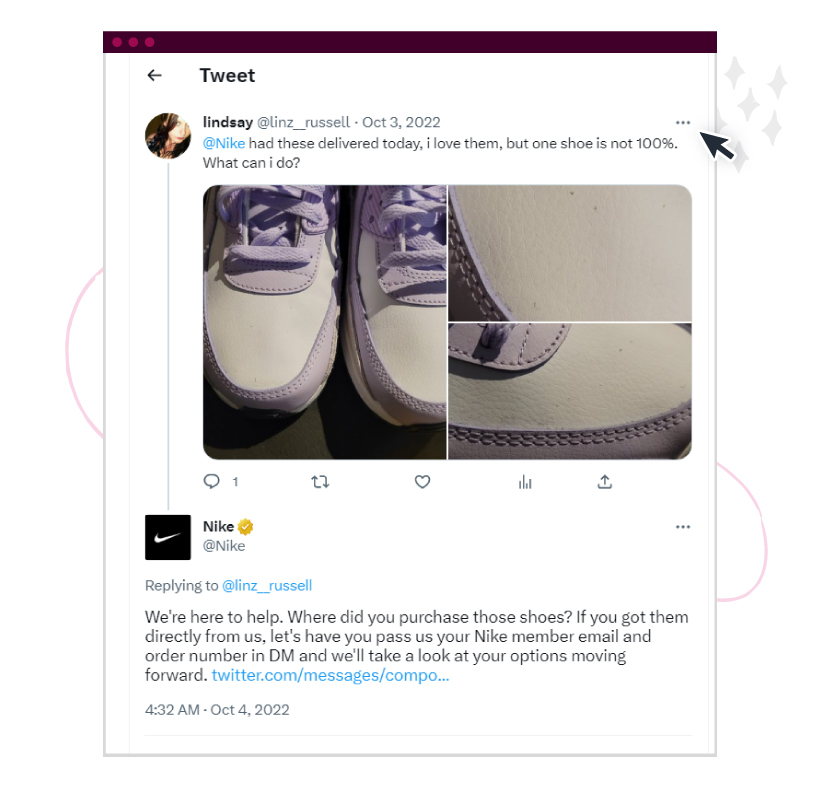Imagine this: An influencer posted some customer complaints about your company on social media. They’re extremely unhappy with your post-sale support. The overall sentiment on the post is pretty discouraging. Additionally, commenters say they’ve experienced the same and will stay away from anything your company is offering. This can be a huge challenge for any business.
Influencer or not, a customer complaining about your product or service warrants your attention. Any unresolved complaint, especially on social media, can have far-reaching consequences for your brand.
In this post, we’ll take a look at why customer feedback is important, tips for developing a customer complaint strategy, and the different ways brands can incorporate customer reviews into their marketing game plans.

The importance of customer feedback
Ignoring customer feedback is one of the worst things you can do for your business. Here’s why you should be receptive to feedback, good or bad.
Identify areas for improvement
Feedback highlights where your business is winning or falling short. Knowing what works and what doesn’t is fundamental to providing superior products and memorable customer experiences.
Understand the customer’s needs
Feedback enables you to understand what customers need and expect from your business. This knowledge can shape your product development, marketing, and customer service strategies.
Boost customer loyalty
Customers want to know their inputs are valued and their feedback is acted upon. Promptly resolving complaints and acknowledging customer reactions is key to establishing a loyal following.
Gain a competitive advantage
In this day and age, the customer yields more power than ever. By building a product and providing a service focused on solving customer pain points, you differentiate your company from the competition.
Developing a strategy for customer complaints
Online reputation management, in a nutshell, is a process that enables companies to maintain control of their brand’s public perception. Building a strong brand involves several online reputation management strategies, including responding to negative comments.
This is where a customer complaint strategy becomes handy. Here are tried-and-tested tips for handling customer complaints.
Listen
When a customer reaches out to complain about something, they want you to listen. The complaint may seem inconsequential, but the fact they’re taking the time to connect means the problem is significant to them.
Be empathetic
Customers want to know that you care. Assure them right away that you’re there to provide an acceptable resolution to their problem.
Acknowledge the problem
Repeating the problem back to the customer confirms you are listening and that you understand the issue at hand.
Apologize
Apologizing doesn’t mean you’re taking the blame, but a sincere apology can pacify an irate customer. It also shows you value the relationship more than your pride and are ready to go the extra mile. In some cases, an apology is all the customer wants.
Thank the customer
A study by Zendesk found that 61% of customers will defect to a competitor after just one bad experience. Make that two, and 76% will be running for the door.
The challenge is that not every dissatisfied customer will inform you of their bad experiences or why they’re unhappy with your product or service. According to former Gartner research director Esteban Kolsky, only one in 26 unhappy customers will complain, and the remaining 25 will quietly leave.
So make it a point to thank the customer for bringing the problem to your attention.
Get the facts
Ask clarification questions, but be sure not to ask questions that make the customer repeat themselves. This can upset them all over again.
Offer a solution
If a customer is complaining about a defective product, sending a replacement or offering a refund is the right way to go. If an unruly group of guests made a customer’s experience at your hotel or restaurant disappointing, for example, a discount coupon may encourage them to give your business another try.
Act fast
The sooner a complaint or negative social media feedback is addressed, the less likely it is to spin out of hand. So answer each complaint as soon as possible.
Follow up
Follow up with the customer to make sure the issue has been resolved to their satisfaction. This demonstrates that you are truly on their side.
Exceed expectations
Go above and beyond. Provide discounts and other incentives that will make customers feel valued.
Create a system to log customer complaints
Make it easy for customers to log complaints. Keep a record of their complaints to spot repetitive issues or customers who frequently encounter problems. A tracking system will also make it easy for your teams to conduct follow-ups.
Using customer reviews in marketing
Customer complaints come with the territory, and handling them the right way can turn anger or regret into an opportunity to build your brand and boost customer loyalty. Plus, customers are inherently suspicious of all perfect reviews, especially if you only have a handful of them. They’d think there’s censorship happening in the background. For most, an imperfect rating is more realistic than full five-star averages.
That being said, here’s how to use customer complaints in your marketing campaigns. We’re adding actual examples and insights from a marketing expert for good measure, too.
Respond to comments publicly
Respond to public comments publicly and promptly to assure your customers that you value their concerns. It also shows potential customers how you address issues. An example is Nike addressing a customer’s query on Twitter. Customer service is the new marketing, after all.
Improve marketing messaging
Another opportunity to improve customer sentiment is to communicate better. Here’s how Ann Handley, a famous marketing author and speaker said it:
“We love our products and services and we understand on an implicit basis what value they bring to your customers or your prospects. But I think that we don’t always communicate that as effectively as we could. We’re not always leading with our hearts. We’re not always touching people in a way that will engage them emotionally.” – Ann Handley via HubSpot
To solve this gap, Ann recommends what she calls “pathological empathy,” or “really understanding, sort of getting inside their skin to get a sense of who [they are] and how [you can] best engage with them emotionally.”
When you regularly keep track of customer feedback, particularly complaints, you begin to identify common issues or themes that you can then use to refine your marketing messaging.
Use negative reviews for targeted marketing
Image source: Snowbird
A compilation of one-star reviews to create a marketing campaign? You probably thought that ridiculous. But not Snowbird, a ski resort in Utah.
Instead of negative reviews slowing them down, they created a targeted marketing campaign aimed at hardcore snowboarders and skiers who would find the “too steep, too hard, too advanced, and too much snow” aspects of the resort appealing.
Leveraging customer complaints to differentiate your brand
An opportunity to create a lasting positive impression presents itself whenever a customer reaches out to complain about your product, service, or process or posts a negative review on social media.
Instead of dreading one-star reviews, embrace them. A complaint provides a window into what customers are thinking, feeling, or experiencing, giving you a chance to rectify the situation and provide what they truly want or need. And if that’s not possible, you can always pull a Snowbird and use negative reviews to weed out the “snowflakes” and attract your target customers.
Need help turning negative reviews into brand-building content? Reach out to a ClearVoice expert today!







